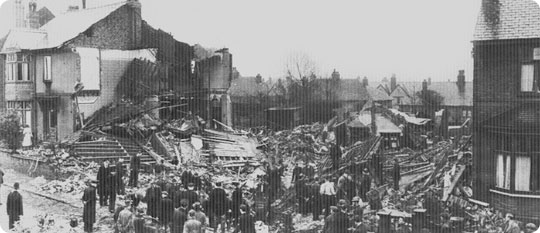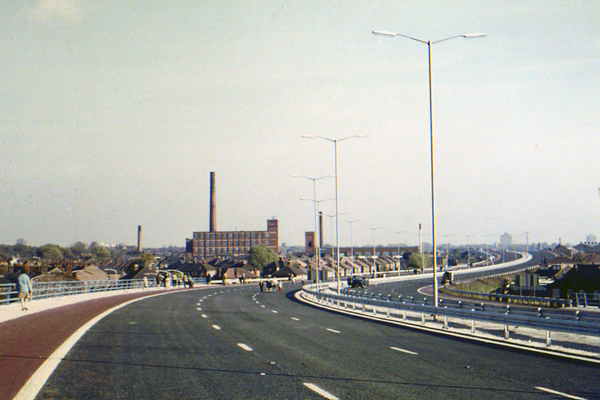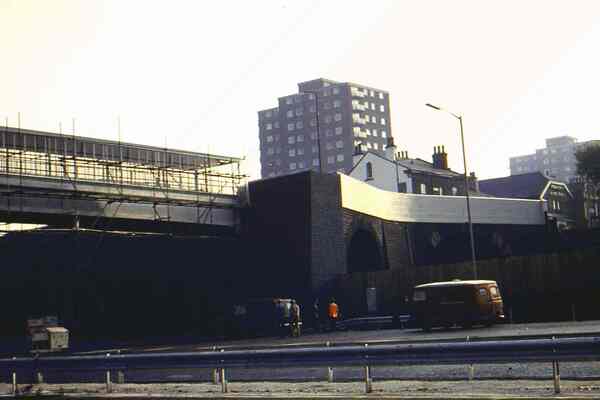
The accident occurred without warning at 5.35am on the morning of Tuesday 28 April.
Locals first noticed a rumbling sound followed by an almighty crash as a railway tunnel which passed underneath Temple Drive collapsed in on itself.
The 'Black Harry' tunnel was on the Patricroft and Clifton branch of the London and North Western Railway line linking Patricroft with Clifton Junction.
Two houses - numbers 22 and 24 were swallowed up and the adjacent house number 26 had its end wall sucked into the pit.
The alarm was raised and at first ambulances arrived with fire brigade and police following swiftly behind them.
Locals hurried to help sift through the debris however confronting them was a crater,20 feet deep and into it was tipped timber, tiles, brickwork and a section of roof.

Agnes Williams, the 77-year-old resident of number 26, was lying near the pavement, buried in rubble up to her waist. She was reported as calm and relatively unscathed while three neighbours pulled her clear.
Her maid, Frances Watson, was then seen standing against the wall of her devastated bedroom, alongside an overturned wardrobe.
Miraculously, she had survived the collapse and rescuers soon brought her down.
Sadly the residents of numbers 22 and 24 were not so lucky.
It was later in the afternoon that the first body was recovered - Fred Potter, aged 87, followed by his wife Clara, 73, and Jean Salt from next door who, at 28, was the youngest victim.
Sara Salt, 69, and daughter Emily, 45, were found still in their beds, 15 feet below ground level.
Black Harry had claimed five lives.
The tunnel collapsed at a point directly beneath an old brick-lined construction shaft, the contents of which fell into the space below, the surrounding soil which was a loose mixture of sand and clay, poured into the hole and formed a large cavity underneath the foundations of the two houses on Temple Drive.
Work to secure the tunnel got underway the following day.
Even this was not without incident. Four workers were overcome by diesel fumes after a concentration of gas build-up caused by lighting equipment.
On 1 May, work came to an abrupt halt after more rumblings were heard, but with ashes packed solidly at either side and timber bulkheads in place, the fall was finally sealed nine days after the roof came in.
Sadly, it appears the Black Harry disaster could have been prevented, as on 15 April 1953, a labourer noticed some bricks had fallen onto the tracks and that more were peeling from the roof.
All traffic on nearby roads was stopped to allow repairs, and it was decided to use steel ribs to reinforce the damaged area. Over the next two weeks, further land movements were detected and cracks started to develop.
Immediate steps were taken to stop rail traffic and arrangements were made to strengthen the tunnel at this point, but before the protective work had been completed, the roof collapsed in the early morning of 28 April.
Brigadier C A Langley conducted the official inquiry on behalf of the Minister of Transport. He concluded that the failure was in no way attributable to mining subsidence but due to an inherent weakness in the construction of the tunnel.
When the old shaft was examined, rotting timbers were found amongst the wreckage.
It was determined that these had been used to brace the shaft when it was filled in after the tunnel was built, and that over time they had corroded, increasing the stress on the walls of the shaft.
When they gave way, the full load of the shaft was transferred to the tunnel roof.
The timber exposed by the original fall of brickwork formed part of a frame which supported this shaft. It was slowly being crushed by a 200-tonne column of wet sand perched on top of it.
This, together with a century of decay, resulted in a massive load being transferred onto the tunnel arch.
When the timber finally gave way, the brickwork could not withstand the pressure, allowing the contents of the shaft to break through catastrophically a vacuum pulled the houses into the void above.
Today there is only a collection of garages to mark the spot of this infamous disaster where 22 and 24 Temple Drive once stood.
This story originally appeared on SalfordOnline on the 12th May 2014 and is reproduced here thanks to Tony Flynn







Recommended Comments
There are no comments to display.
Create an account or sign in to comment
You need to be a member in order to leave a comment
Create an account
Sign up for a new account in our community. It's easy!
Register a new accountSign in
Already have an account? Sign in here.
Sign In Now